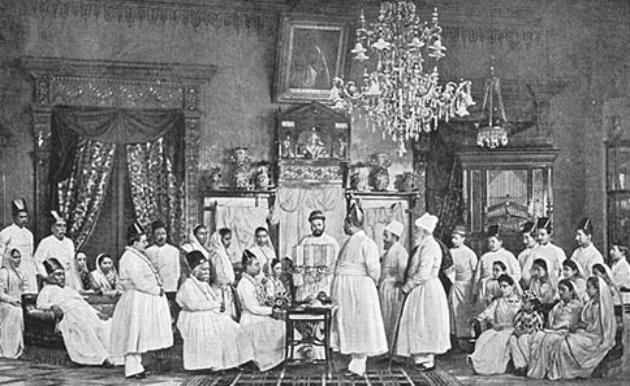
Parsee Parsi Textile
Large & Rare Jari or Zardozi-Embroidered Zoroastrian Hanging
Parsee (Parsi) People, probably Bombay, India
circa 1890-1930
height: 293cm, width: 216cm
This large wall hanging is from the Parsee (Parsi) community of West India, and most probably Bombay. It dates to the end of the nineteenth century and possibly a little later and seems to be an exceptionally rare wall hanging, either for a particularly wealthy family perhaps to be hung in a grand mansion, or perhaps to be used in conjunction with a Parsee theatre troupe, possibly as a back drop.
According to Stewart (2013, p. 200), the 1889 publication in Bombay of a book by K.D. Kiash called
Sculpted Figures of Zoroaster, Adershir Babejan and Shapoor I – Takhat-i-Bostan Ancient Persian Sculptures: On the Monuments, Buildings, Bas Reliefs Rock Inscriptions, &c…, re-ignited enormous interest in ancient Persian bas reliefs and rock sculptures and evoked nostalgia and a sense of longing for Persia among Bombay’s Parsee community. Locally-made silver began to be produced that incorporated ancient Persian images such as old kings and reproductions of rock carvings at Persopolis and Mount Behistun. It is in this context that the embroidered hanging here can be seen.
Parsee theatre troupes were enormously popular and influential in the wider community in northern India, and the renewed interest in Persopolis and ancient history was reflected in the stage shows that the troupes staged. One,
Kushrow Shirin, based on a famous Persian poem and written by Sorabjee Pochkhanawala, had such historical themes and according to Doshi (2002) required ‘elaborate’ sets’. ‘The theatre groups vied with one another in introducing elements of novelty in their productions. A speciality of Parsi theatre was the scenic backdrops employed in the production. Realistically painted, magnificent palace interiors, mountainous landscapes, magnificent palace interiors or townscapes with streets and buildings. Enormous amounts of money were spent commissioning these for use in plays.’ (Doshi, 2002, p. 486). It is possible that the wall hanging here was produced for just this purpose.
It comprises gold thread embroidery and spangle applique work over thick purple velvet. Such work is known as
jari work, which was centred on Surat, and is similar to the thick embroidery work in gold and silver thread on velvet known as zardozi work undertaken for the Mughal and Lucknow courts to decorate wall hangings, shoes, jackets and even umbrellas. Jari work is more typically seen on smaller articles for wear such as the caps and jackets commissioned for initiation (navjote) rituals.
The embroidered pattern is architectural and possibly based on the rock-face tomb of Darius the Great at Naqsh-i Rustam in Iran which has a facade designed to emulate the entrance to a palace. It shows a pediment with a winged Ahuramazda emblem with columns decorated with hieroglyphic-like emblems. The structure sits on three rising steps that are embroidered with differing scrollwork.
Eight lines of cuneiform script are embroidered between the columns. The inscription has been copied from part of a fifth-sixth century BC inscription in cuneiform at Mount Behistun (Bisitun) in the Kermanshah Province of Western Iran (Persia). The inscription was authored by Darius the Great, and includes a brief biography of him as well as information about his lineage. It has been transliterated as:
Ahuramazda thuyam daushta biya
Uta-taiy tauma vasiy biya
Uta dra(n)gam jiva
which has been further translated to read:then may Ahuramazda be your friend
may your family be numerous
and may you live long
The surrounding text as it appears in what is known as column four on the rocks at Behistan have been translated to read:King Darius says: Those who were the former kings, as long as they lived, by them was not done thus as by the favor of Ahuramazda was done by me in one and the same year.
King Darius says: Now let what has been done by me convince you. For the sake of the people, do not conceal it. If you do not conceal this edict but if you publish it to the world, then may Ahuramazda be your friend, may your family be numerous, and may you live long.
King Darius says: If you conceal this edict and do not publish it to the world, may Ahuramazda slay you and may your house cease….
The Behistun inscriptions were translated and refined progressively in the 19th century. Sir Henry Rawlinson, an officer of the British East India Company, began studying the inscription intensively from 1835. Rawlinson was able to decipher the type of cuneiform used for Old Persian by 1838 and presented his results to the Royal Asiatic Society in London and the Société Asiatique in Paris.
Scenes carved into the rock and co-located with the cuneiform inscription at Mount Behistun were repoussed onto the sides of a large memorial or
muktad bowl made for a wealthy Bombay Parsee family in the last 19th century. See
here
for that bowl which is now in the Asian Art Museum in San Francisco.
The original dyed orange-red cotton backing to the textile (which has been replaced with a more stable backing but has still been retained separately) has a brief, hand-written inscription in old Gujarati text (see below), which has been translated by Dastur Kotwal, the High Priest of the India’s Parsi Community, as:
Zamereche Nar Badwhich, according to the High Priest, comes from the Yasht Prayers. The word ‘Zamereche’ is preceded by the words ‘Yasnemcha Vahmencha’. ‘Zamereche’ means ‘strength’ or ‘more power’ and ‘Nar’ might mean ‘evil’ or ‘impurity’. ‘Bad’ means ‘blessings’. So ‘Zamereche Nar Bad’ might be interpreted as an incantation, possibly giving blessings or strength to remove evil, misfortune or bad luck. The use of old Gujarati is unusual. It was in use approximately between 1100AD and 1500AD. The use of such old script might have been meant to enhance the mystical value of the incantation. If the wall hanging was intended for a large family home then the blessing makes sense. Equally, if the hanging was designed for a theatre then the blessing might have been designed to bestow good fortune on the production and actors.
Parsees subscribe to Zoroastrianism, one of the world’s oldest living religions. Darius was crowned king of Persia in 522 BC, and was the first of the Achaemenid kings to be confirmed as a true follower of Zoroaster. Ahura Mazda, proclaimed by Zoroaster as God, was mentioned and celebrated as Creator in many of Darius’ speeches.
Under the kings of the Achaemenian line, the religion became one of the great religions of the ancient East. But it shared the fate of the Persian monarchy, it was shattered, though not overthrown, by the conquest of Alexander and it fell into neglect. With the Arab conquest in the seventh century came Islam and Zoroastrianism was vigorously repressed. A group of Zoroastrians fled in 936AD to Gujurat in India. By the seventeenth century, most had moved to Bombay, with smaller communities in Karachi and Rangoon. (Later small communities existed in Singapore and Hong Kong.) The Bombay community today is the world’s largest, far exceeding the relative handful of Zoroastrians that remain in Iran.
Zoroastrianism teaches the importance of the elements, particularly fire. Zoroastrian pilgrims had for example come from Persia during the Middle Ages onwards to erect temples and worship the then mysterious fire that shot out of the earth in certain parts of Azerbaijan, fuelled by underground wells of natural gas. A belief in the existence of angels is another important Parsee belief. Angels guide individuals and events.
Each Parsee fire temple has a central, sacred flame that is never allowed to go out. (Bombay/Mumbai has around fifty fire temples.) Traditionally, the bodies of dead Parsees are laid out in so called ‘Towers of Silence’ and crows are then allowed to feed on them. Cremation would ‘pollute’ fire and burial would ‘pollute’ the earth. In Bombay, the principal Towers of Silence are adjacent to city’s so-called ‘Hanging Gardens’.
Today, probably there are about 125,000 Parsees or Zoroastrians worldwide. About 70,000 live in Mumbai/Bombay, a city of 14 million people. Another 1,700 live in Karachi in Pakistan.
Like Europe’s Jewish communities or the Chinese of Southeast Asia, the Parsees of India and Pakistan are a distinct but exceptionally successful commercial minority. By the nineteenth century, Bombay’s Parsee families dominated the city’s commercial sector, particularly in spinning and dyeing and banking.
Wealth from these activities was put into property so that by 1855, it was estimated that Parsee families owned about half of the island of Bombay. Today, India’s most prominent Parsee family is the Tata Family, founders and owners of India’s most prominent conglomerate the Tata Group.
Well off though they are as a community, the Parsees are dying out. It has been estimated that a thousand Parsees die each year in Mumbai, but only 300-400 are born. Today, one in five Mumbai Parsees is aged 65 or more. In 1901 the figure was one in fifty. Low birth rates are the main factor. Probably no Parsees remain in Burma today.
Nonetheless, many vestiges of the Parsees’ contribution to commerce in South and East Asia remain. Apart from India’s giant Tata Group, smaller examples can be seen: small change offices in Hong Kong are known locally as ‘schroffs’ after a common Parsee surname, and in Singapore the road that runs alongside that country’s finance ministry is known as Parsi Road.
The wall hanging here is in excellent condition with very few losses. Small areas of insect damage have been professionally repaired. The velvet shows little crushing and retains its rich hue. The embroidery is largely intact and remains bright. The excellent condition most probably is a combination of its having come from a Parsee family or source originally and the Parsees until this day in India enjoy a reputation for taking great care of their things, and latterly because the textile has been in England with its relatively benign atmospheric and pest-free conditions.
References
Doshi, S., ‘Of costumes and sets: Parsi theatre’, in Godrej, P.J. & F. Punthakey Mistree, A Zoroastrian Tapestry: Art, Religion & Culture, Mapin Publishing, 2002.
Framjee, D.,
The Parsees: Their History, Manners, Customs and Religion, Asian Education Services, 2006 (first published in 1858.)
Godrej, P.J. & F. Punthakey Mistree,
A Zoroastrian Tapestry: Art, Religion & Culture, Mapin Publishing, 2002.
Punthakey Mistree, F., pers. comm., February 2015.
Shah, S., & T. Vatsal,
Peonies & Pagodas: Embroidered Parsi Textiles – The Tapi Collection, Garden Silk Mills, 2010.
Stewart, S. (ed.),
The Everlasting Flame: Zoroastrianism in History and Imagination, SOAS, 2013.Provenance:
private collection, UK.
Inventory no.: 3019
SOLD

A Parsee wedding, 19th century Bombay.
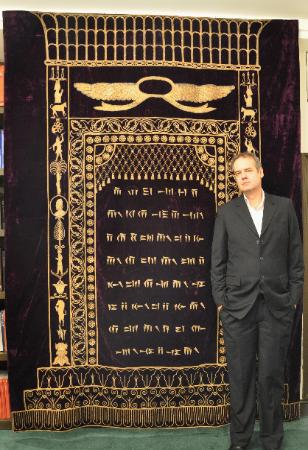
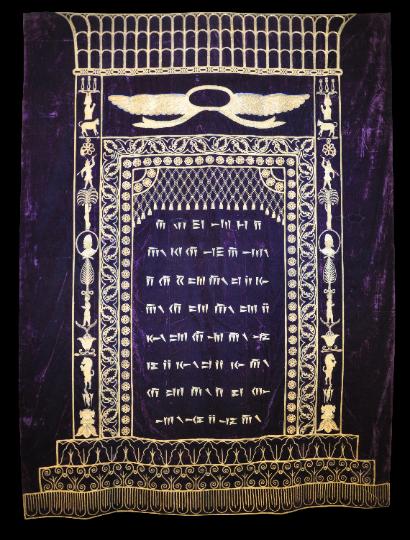
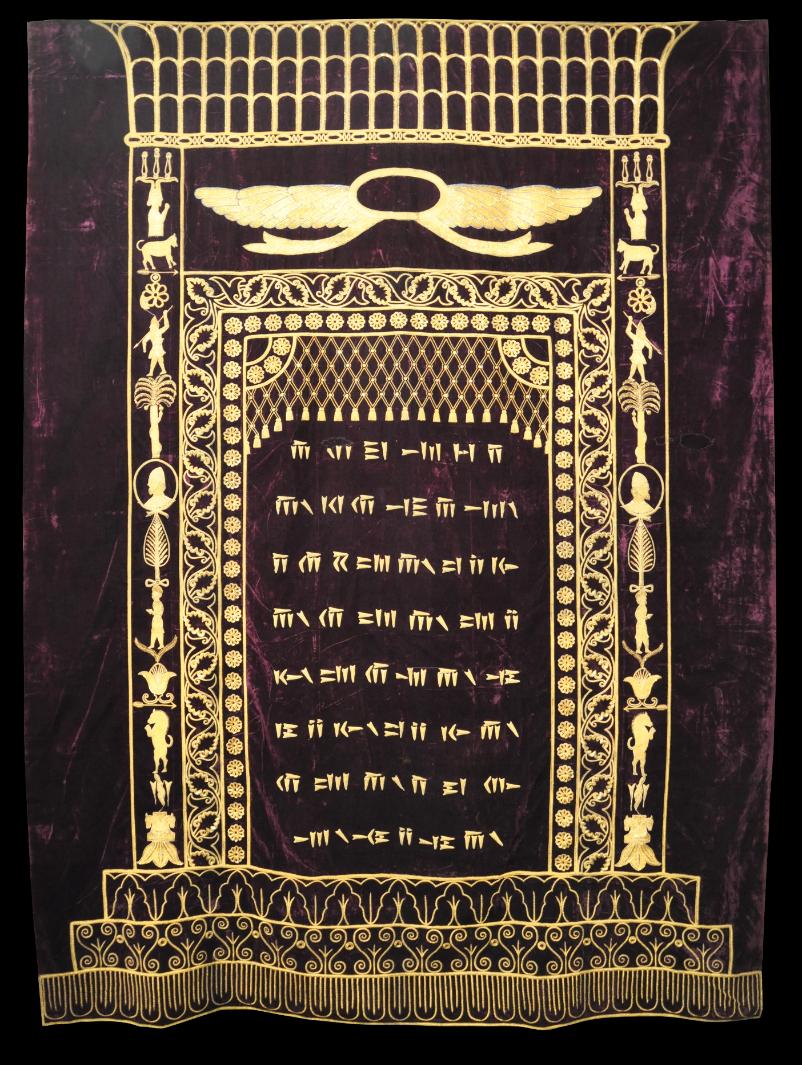
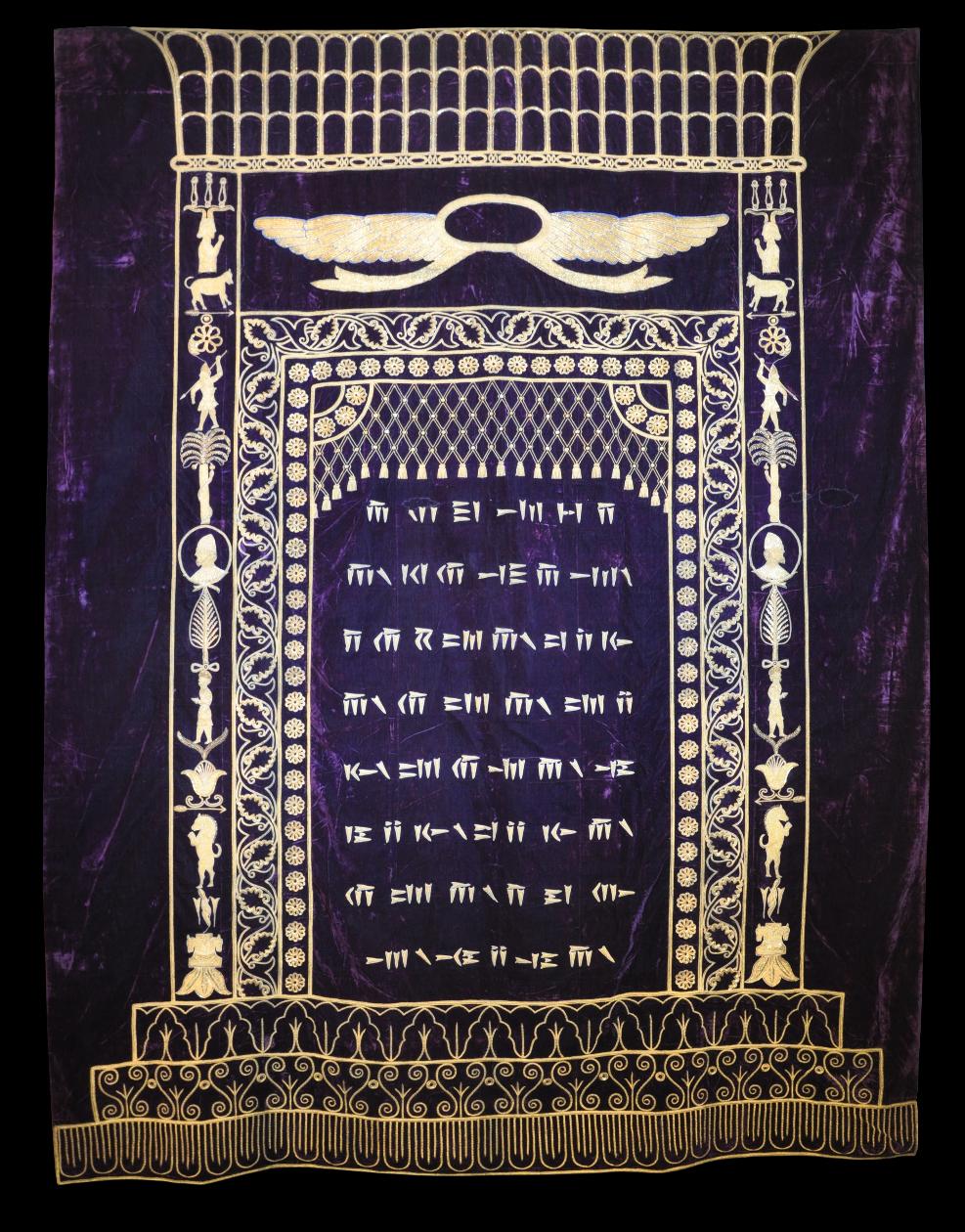
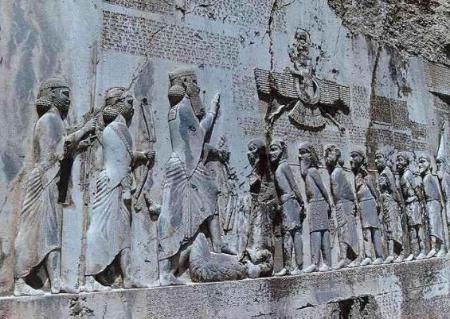
A Parsee family group, Bombay.
The bas relief with inscriptions at Behistun, Iran.
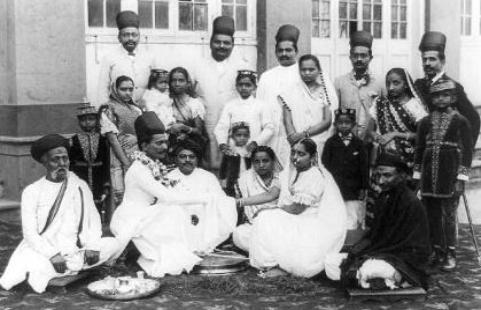
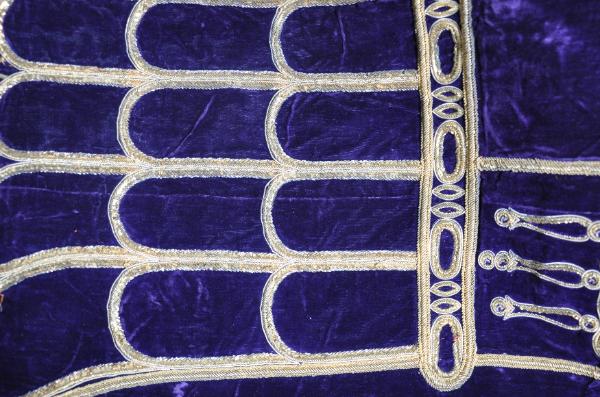
The following close-up detail images provide a better indication of the richness of the colours of the textile
compared with the larger, overall images.
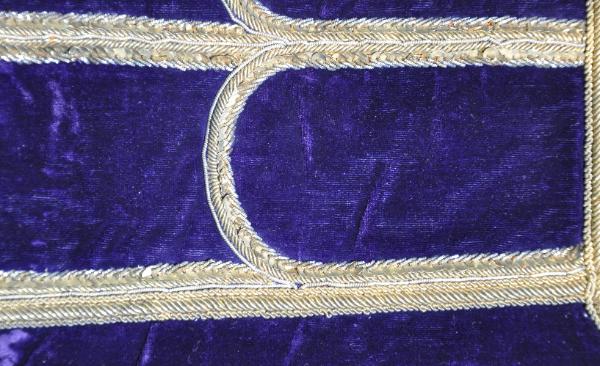
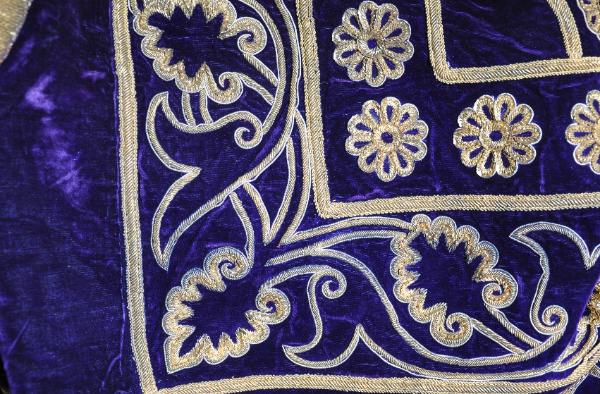
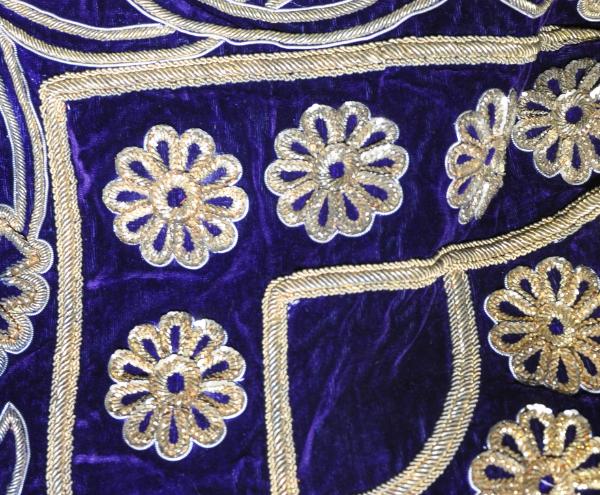
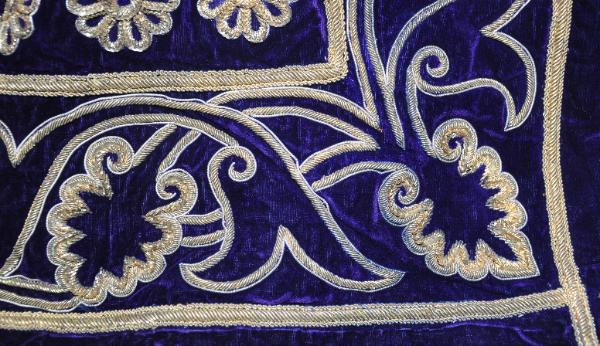
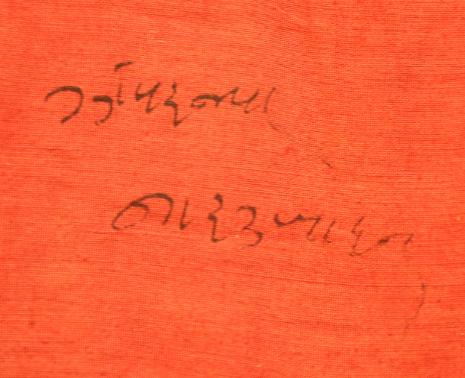
The old Gujarati text on the wall hanging’s backing.

